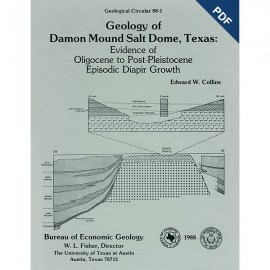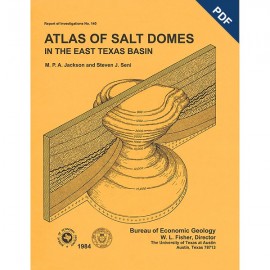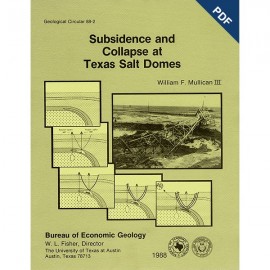Reports of Investigations
-
Books & Reports
- Reports of Investigations
- Guidebooks
- Udden Series
- Geological Circulars
- Down To Earth
- Atlases of Major Oil and Gas Reservoirs
- Texas Memorial Museum Publications
- Environmental Geologic Atlas of the Texas Coastal Zone
- Mineral Resource Circulars
- Other Reports
- Seminars and Workshops
- Handbooks
- Submerged Lands of Texas
- Symposia
- Annual Reports
- Open File Reports
-
Maps & Cross Sections
- Thematic Maps
- Miscellaneous Maps, Charts & Sections
- Geologic Atlas of Texas
- STATEMAP Project Maps
- Geologic Quadrangle Maps
- Cross Sections
- Highway Geology Map
- Energy and Mineral Resource Maps
- Shoreline Change and Other Posters
- Wilcox Group, East Texas, Geological / Hydrological Folios
- Bouguer Gravity Atlas of Texas
- River Basin Regional Studies
- Featured Maps
- Posters
- Teachers & the Public
-
Geological Society Publications
- Gulf Coast Association of Geological Societies
- Alabama Geological Society
- Austin Geological Society
- Corpus Christi Geological Society
- Houston Geological Society
- Lafayette Geological Society
- Mississippi Geological Society
- New Orleans Geological Society
- South Texas Geological Society
- GCS SEPM Publications
- Historic BEG & UT Series

Hydrogeology of Barbers Hill Salt Dome, Texas Coastal Plain. Digital Download
RI0176D
For a print version: RI0176.
RI0176D. Hydrogeology of Barbers Hill Salt Dome, Texas Coastal Plain, by H. S. Hamlin, D. A. Smith, and M. S. Akhter. 41 p., 29 figs., 9 tables, 3 appendices, 1988. doi.org/10.23867/RI0176D. Downloadable PDF.
To purchase this publication in book format, please order RI0176.
ABSTRACT
Barbers Hill salt dome, located in the Texas Coastal Plain near Houston, has a long history of resource exploitation, including oil and brine production, storage of hydrocarbons in solution-mined caverns within the salt stock, and disposal of brine into the cap rock. Industrial and municipal facilities are concentrated over the dome, and large amounts of ground water are produced within 12 mi (20 km) of the structure. Subsurface data from closely spaced petroleum, brine-disposal, and water wells were used in characterizing near-dome hydrogeology at Barbers Hill. The purpose of this study is to provide a better understanding of ground-water flow and hydrochemistry around a soluble salt dome and to present information that could be helpful in avoiding problems associated with high-density use of surface and subsurface resources under similar hydrogeologic conditions.
Barbers Hill Dome is a shallow (<400 ft [120 m] deep), slightly tilted salt diapir about 10,000 ft (3,050 m) wide at it8 crest. It has well-developed salt overhangs and a thick (>500 ft [150 m]) cap rock composed of anhydrite, gypsum, and calcite. The dome is enclosed in a thick sequence of Cenozoic terrigenous clastic sediments. Fine-grained marine sediments surround the deeper dome flanks, but sand-rich fluvial-deltaic facies dominate shallower strata. Active diapirism has uplifted strata against the dome flanks. Salt flowing into the growing diapir at depth has left peripheral salt-withdrawal basins, which are synclinal features filled with overthickened sedimentary strata. Domal uplift is still active, arching Pliocene to Pleistocene strata and creating the circular hill that overlies the diapir.
Permeability distributions, environmental-water heads, pumping-test results, and numerical modeling suggest that hydrologic communication exists between Barbers Hill cap rock, shallow fresh-water sands, and deeper sands containing saline water and hydrocarbons. Every month several million barrels of brine are injected into Barbers Hill cap rock, which contains highly porous and permeable zones. Saline fluids from salt dissolution and deep formations also occur in the cap rock and around the dome flanks. Thick aquifer sand bodies around the dome flanks thin or pinch out toward the crest. Even so, as much as 1,000 ft (310 m) of permeable sands in the Evangeline aquifer are in contact with cap rock. Comparisons of calculated environmental-water and freshwater heads, which normalize fluid-density variations, delineate steep hydraulic gradients directed upward and outward, away from the cap rock. Pumping tests show that the boundary between the cap rock and enclosing sediments is transmitting fluids. During a long-term injection test, brine levels in observation wells in cap rock rose initially but eventually stabilized, matching theoretical solutions for idealized aquifers that are leaking fluids across broad areas vertically and laterally. Numerical modeling indicates that substantial rates of vertical leakage out of the cap rock are possible and are consistent with the injection-test data.
Active diapirism, salt dissolution, and cap-rock formation at least partly contribute to heterogeneous vertical and lateral variations in ground-water salinity and composition in Chicot and Evangeline aquifer sands around Barbers Hill. Electric-log interpretation and results available from successive (1958 to 1986) water-well chemical analyses delineate a growing area of abnormally high ground-water salinities in the lower Chicot aquifer south and west of the dome. This high salinity is attributed to natural mixing of dome-related fluids with circulating meteoric waters, although recent dramatic increases in dissolved solids (especially chloride) suggest that brine disposal is accelerating salinization. Continued high-volume cap-rock brine disposal increases the risk of further contamination of ground-water resources.
Keywords: brine disposal, cap rock, Chicot aquifer, Evangeline aquifer, Gulf Coastal Plain, ground water, hydrology, salt dome, Texas, water quality
CONTENTS
Abstract
Introduction
Objectives and methods
Geology
Dome geometry
Cap rock
Stratigraphy
Structure
Hydrology
Hydrogeologic units
Burkeville aquitard
Evangeline aquifer
Chicot aquifer
Cap-rock aquifer
Hydraulic heads and gradients
Sand aquifers
Cap-rock aquifer
Cap-rock disposal-well hydraulics
Numerical modeling
Cap-rock model
Results and discussion
Ground-water chemistry
Resistivity-derived ground-water salinities
Hydrochemical patterns from water-well analyses
Temporal changes in composition and salinity
Conclusions
Acknowledgments
References
Appendices
A. Cap-rock disposal wells used in injection tests
B. Data used to graph electric-log resistivity versus total dissolved solids
C. Results of chemical analyses of lower Chicot ground waters from Mont Belvieu public-supply water well
Figures
1. Location map of Barbers Hill salt dome
2. Structure·contour map of Barbers Hill Dome
3. Monthly rates of brine disposal into Barbers Hill cap rock
4. Well-location map showing well-log control for structural cross sections
5. Well-location map showing detailed local control for fence diagram
6. Location map of water wells around Barbers Hill Dome
7. Isometric block diagrams of Barbers Hill Dome
8. Cross section of cap-rock facies and porous zones, Barbers Hill Dome
9. Structural cross sections, Barbers·Hill area
10. Net-sand map of the lower Chicot aquifer
11. Map of surficial sediments and depositional facies around Barbers Hill Dome
12. Structure-contour map, top of Frio Formation
13. Fence diagram, Barbers Hill Dome
14. Potentiometric surfaces, lower Chicot and Evangeline aquifers
15. Location map of cap-rock observation and injection wells
16. Hydrograph of the long-term cap-rock injection test
17. Vertical environmental-water·head gradients
18. Pressure-versus-time plots, Barbers Hill cap rock
19. Measured head rises in cap·rock observation wells
20. Finite·element grid used in the numerical model of Barbers Hill cap rock
21. Hydrographs comparing measured, theoretically predicted, and numerically simulated head rises
22. Graph of total dissolved solids versus electric-log resistivity
23. Cross sections from the fence diagram
24. Resistivity map of the lower Chicot aquifer
25. Electric cross section L-L’
26. Map of total dissolved solids in well waters around Barbers Hill
27. Map of chloride concentrations in well waters around Barbers Hill
28. Piper diagram showing ground-water compositions around Barbers Hill
29. Temporal changes in dissolved·ion concentrations in Mont Belvieu public-supply water well
Tables
1. Stratigraphic column, Barbers Hill area
2. Hydrogeologic units, Barbers Hill area
3. Cap·rock observation-well and fresh-water-well data
4. Hydrologic parameters used in the numerical cap-rock model
5. Comparison of fresh-water head rises
6. Ground-water salinity/electric-log resistivity classification of Chicot and Evangeline sands around Barbers Hill Dome
7. Total dissolved solids and chloride concentrations in water wells, Barbers Hill area
8. Hydrochemical facies in ground water around Barbers Hill Dome
9. Changes in dissolved-ion concentrations in the Mont Belvieu public-supply water well
Citation
Hamlin, H. S., Smith, D. A., and Akhter, M. S., 1988, Hydrogeology of Barbers Hill Salt Dome, Texas Coastal Plain: The University of Texas at Austin, Bureau of Economic Geology, Report of Investigations No. 176, 41 p.




